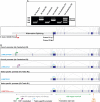Primate segmental duplication creates novel promoters for the LRRC37 gene family within the 17q21.31 inversion polymorphism region
- PMID: 22419166
- PMCID: PMC3371713
- DOI: 10.1101/gr.134098.111
Primate segmental duplication creates novel promoters for the LRRC37 gene family within the 17q21.31 inversion polymorphism region
Abstract
The LRRC37 gene family maps to a complex region of the human genome and has been subjected to multiple rounds of segmental duplication. We investigate the expression and regulation of this gene family in multiple tissues and organisms and show a testis-specific expression of this gene family in mouse but a more ubiquitous pattern of expression among primates. Evolutionary and phylogenetic analyses support a model in which new alternative promoters have been acquired during primate evolution. We identify two promoters, Cl8 and particularly Cl3, both of which are highly active in the cerebellum and fetal brain in human and have been duplicated from a promoter region of two unrelated genes, BPTF and DND1, respectively. Two of these more broadly expressed gene family members, LRRC37A1 and A4, define the boundary of a common human inversion polymorphism mapping to chromosome 17q21.31 (the MAPT locus)-a region associated with risk for frontal temporal dementia, Parkinsonism, and intellectual disability. We propose that the regulation of the LRRC37 family occurred in a stepwise manner, acquiring foreign promoters from BPTF and DND1 via segmental duplication. This unusual evolutionary trajectory altered the regulation of the LRRC37 family, leading to increased expression in the fetal brain and cerebellum.
Figures





References
-
- Bailey JA, Eichler EE 2006. Primate segmental duplications: Crucibles of evolution, diversity and disease. Natl Rev 7: 552–564 - PubMed
-
- Bailey JA, Gu Z, Clark RA, Reinert K, Samonte RV, Schwartz S, Adams MD, Myers EW, Li PW, Eichler EE 2002. Recent segmental duplications in the human genome. Science 297: 1003–1007 - PubMed
-
- Baker M, Litvan I, Houlden H, Adamson J, Dickson D, Perez-Tur J, Hardy J, Lynch T, Bigio E, Hutton M 1999. Association of an extended haplotype in the tau gene with progressive supranuclear palsy. Hum Mol Genet 8: 711–715 - PubMed
-
- Barton GM, Medzhitov R 2002. Toll-like receptors and their ligands. Curr Top Microbiol Immunol 270: 81–92 - PubMed
-
- Bengesser K, Cooper DN, Steinmann K, Kluwe L, Chuzhanova NA, Wimmer K, Tatagiba M, Tinschert S, Mautner VF, Kehrer-Sawatzki H 2010. A novel third type of recurrent NF1 microdeletion mediated by nonallelic homologous recombination between LRRC37B-containing low-copy repeats in 17q11.2. Hum Mutat 31: 742–751 - PubMed
Publication types
MeSH terms
Substances
Associated data
- Actions
- Actions
- Actions
- Actions
Grants and funding
LinkOut - more resources
Full Text Sources
